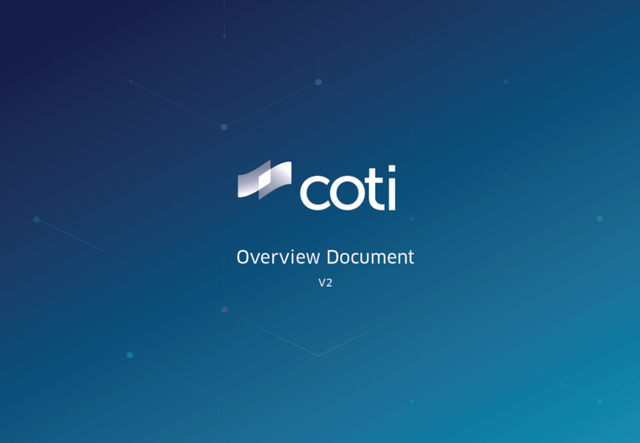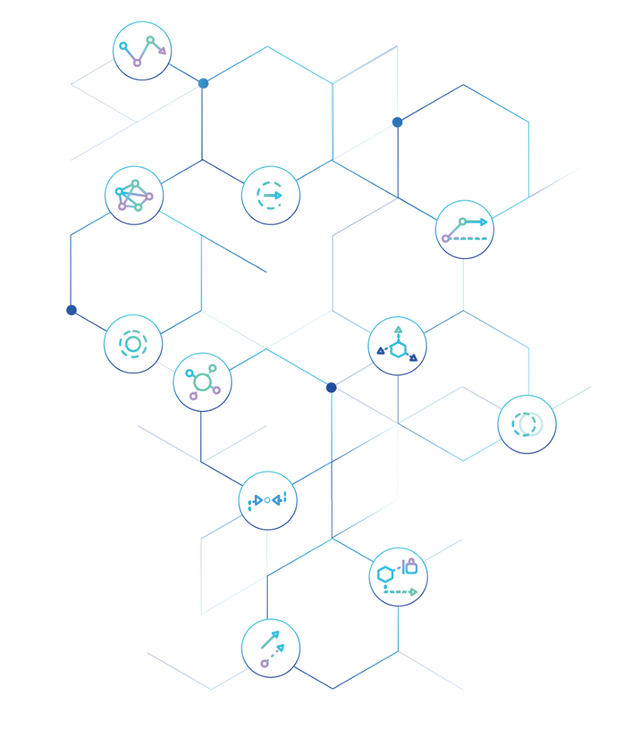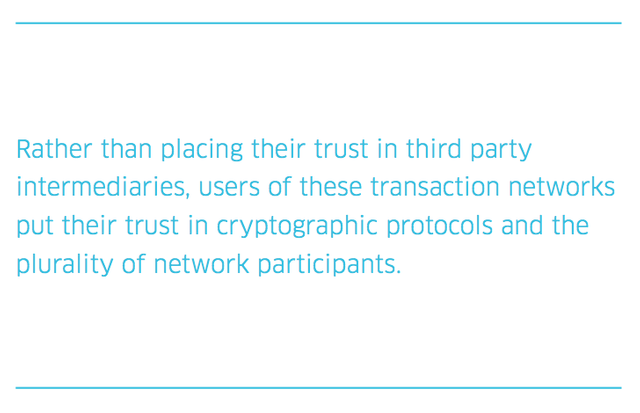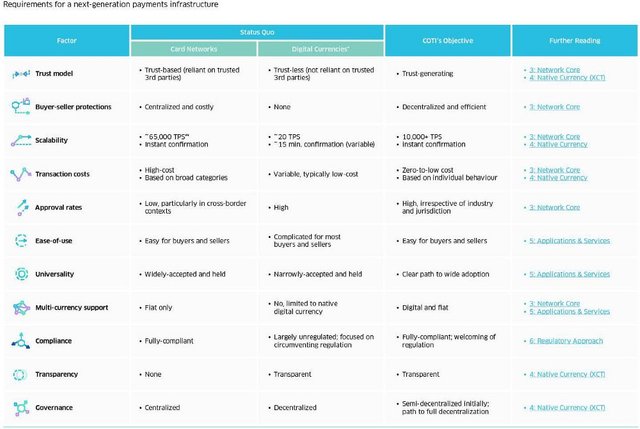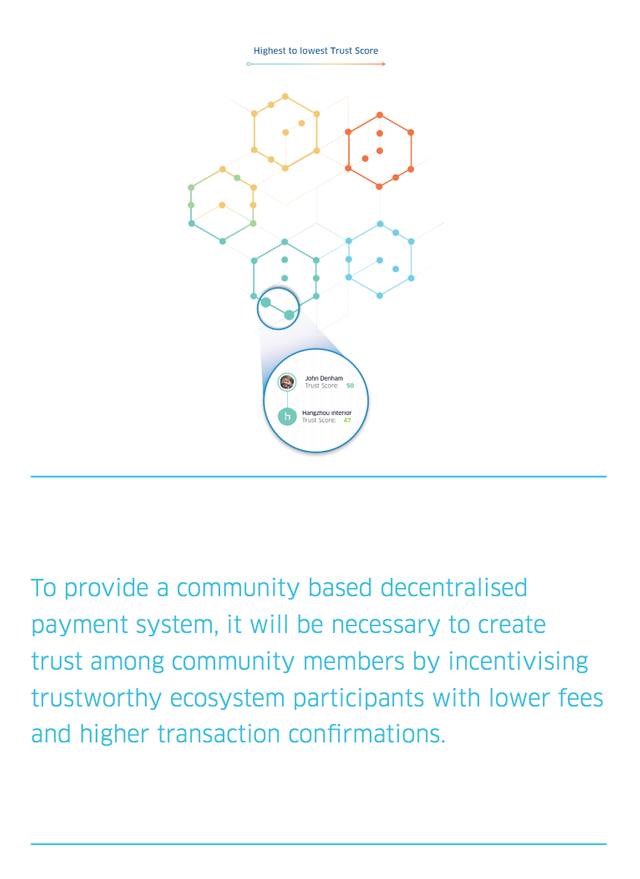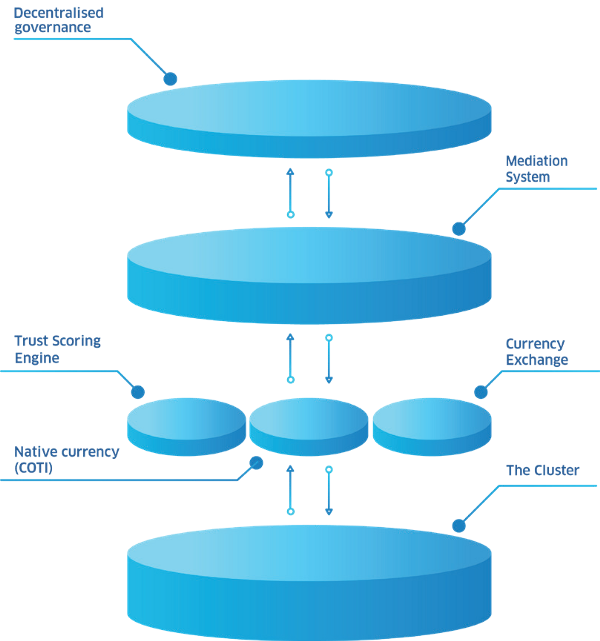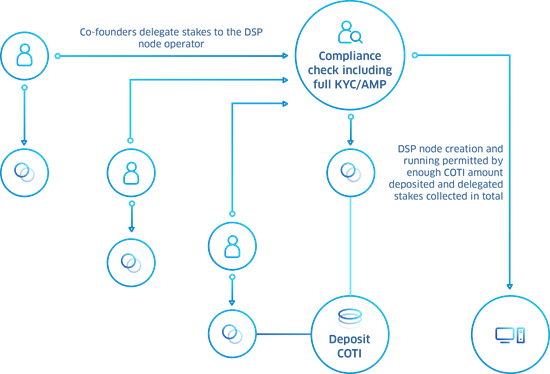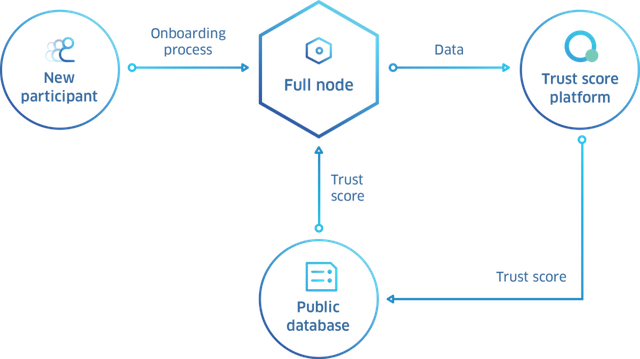COTI Overview Document - part I
COTI’s vision is to build a decentralized and scalable payments network to facilitate efficient global commerce. This will set the standard for a next generation payment solution that is trust-driven, instant, cost-effective and supportive of a multi-currency wallet. By reconciling cutting edge distributed ledger technologies with the best of traditional payment solutions, COTI will be poised to spearhead the mass adoption of digital currencies in the mobile era.
To elucidate the scope of this solution, it is relevant to note that the online payments industry encompasses over 1.6 billion people worldwide.
Transactional volumes exceeded two trillion dollars in 2016 and are projected to double by 2020, while e-commerce has been amplified by increasing mobile payments. According to recent research, the volume of US in-store mobile payments is expected to grow at an annual CAGR (compound annual growth rate) of 80% between 2015 and 2020. Transaction volume is forecast to reach $500 billion by 2020, and user growth is expected to increase concurrently, exceeding 150 million mobile users in the same year.
At present, decentralized online payment systems lack the ability to scale in volume and speed, and the effect is most apparent with cryptocurrencies. Although several Blockchain technologies have tried to achieve a high throughput of transactions per second (TPS), it has remained an elusive goal due to scalability challenges.What’s more, current online and mobile payment solutions have recently been dealing with inadequacies that have constrained market growth while downgrading user and merchant satisfaction:
• High processing fees. Credit card networks charge a number of fees including annual fees, late fees, balance transfer fees, expedited payment fees and more, which are imposed on both the consumer and the merchant.
• Long settlement periods with high rolling reserves. A payment can take up to two weeks to settle and for the merchant to be paid, particularly as it concerns high-risk transactions designated by credit card networks. In such instances, provisions are withheld from merchants, potentially causing severe liquidity issues and driving up the prices of goods and services.
• Absence of a shared trust mechanism. Currently, credit scores and ratings are marketplace-specific and non-transferable across platforms. Consumers and merchants who have worked hard to obtain high ratings cannot migrate seamlessly to another marketplace without ceding their accumulated trust ratings.
• Lack of multi-currency support. While credit cards support fiat money, users have no control over currency exchange rates. What’s more, digital currencies have not yet been integrated into credit card networks.
To this end, COTI is developing a variety of technologies that will work in concert to provide consumers and merchants with a vastly improved payment experience utilizing a globally decentralized digital currency, Currency Of The Internet (COTI),and a comprehensive payment ecosystem characterized by a number of key features:
— Instantaneous remittance that utilizes distributed ledger technology in the form of a DAG (directed acyclic graph) structure.
— A global Trust Scoring Engine, which automatically assesses the interactions between buyers and sellers over time, assigning each network participant a unique Trust Score. Trust Scores provide a numerical representation of the relative value that each participant contributes to the COTI network and are used to assign network fees. It also facilitates the decision-making process by users and merchants and removes the dependence on a single centralised marketplace for ratings.
— A Mediation System that resolves disputes between transacting parties and maintains the integrity of the network. A first of its kind, the system leverages data science, game theory and an independent network of crowdsourced mediators to resolve disputes fairly and efficiently — without prompting a substantial increase in transaction costs.
— Currency exchange integration that provides network participants with a means of moving seamlessly between currencies — both fiat and digital — by aggregating liquidity from internal and external liquidity pools. The exchange is complemented by an automated market-maker, which maintains fair and orderly markets in a range of currencies.
— COTI is developing a suite of applications and services that will provide consumers, merchants and crowdsourced mediators with seamless connectivity to the COTI network. For consumers, the COTI wallet and debit card will facilitate the secure storage, transmission, and exchange of digital and fiat currencies. For merchants, COTI’s processing solutions will facilitate the acceptance of payments in a variety of fiat and digital currencies while substantially lower processing fees. For mediators, the dedicated client will enable mediators to contribute to, and be compensated for, the successful resolution of transaction disputes.
COTI is currently laying down the licensing foundations that will enable it to comply with existing regulations, both as a payments network and a currency exchange. With respect to COTI — and the handling of digital currencies more generally — the COTI team welcomes greater regulatory clarity and believes digital currency-specific frameworks will serve as a catalyst for the mainstream adoption of digital currencies. To this effect,
COTI is in the process of applying for a distributed ledger technology (DLT) license in Gibraltar and has initiated dialogues with regulators globally to help shape its legal framework. In the interim, COTI is adopting banking industry compliance standards to ensure that its digital currency-related activities do not serve as a conduit for money laundering or other illicit activity.
The COTI team includes veterans of the payment, cryptography, asset management and banking industries. These experts possess experience in worldwide payment solutions ranging from Processing.com and Markets. com to Investec Bank, BlackRock and HSBC. The team has set ambitious development targets and is on track to launch the first phase of the COTI network in the fourth quarter of 2018. Thereafter, COTI will build upon its robust technical foundations and forge its way to streamline online payments. Ultimately, COTI will enable higher global trade volumes by enabling the free flow of value in the same way that the Internet enables the free flow of information.
1. Context
Worldwide consumer payment transactions exceed $50 trillion annually and are increasingly carried out using electronic payment methods. Yet despite the intense competition within the payments industry, consumers and merchants face high fees and low approval rates. Digital currencies could represent a compelling alternative, but are not practical to use in common payment contexts in their current form.
•Cross-border e-commerce. Cross-border B2C e-commerce is expected to reach one trillion dollars in annual transaction volume by 20204, the clear majority of which will be performed using card-based solutions. However, as a consequence of the four-party model (consumers, retailers, issuers and acquirers) adhered to by major card networks, transactions involving card issuers and card acquirers located in different regions are inherently less reliable than equivalent domestic transactions. Cross-border card payments are encumbered by higher fees, higher abandonment rates and lower approval rates relative to domestic transactions. For US-based merchants, cross- border transactions are 2–3 times more likely to be declined relative to domestic transactions, and some 31% of declined transactions turn out to be false positives.
•Online marketplaces. Online marketplaces connecting buyers and sellers can work with existing payment solutions to an extent. However, key functions normally handled by the card networks (e.g., dispute resolution) must be administered internally by the marketplace operators. The internalization of these functions adds considerable operational overhead to each marketplace and raises the barriers to entry to would-be competitors. Moreover, marketplaces that lack the capital or appetite to manage the operational burden of internalizing these key functions are unable to offer payment capabilities to their marketplace participants.
•Peer-to-peer commerce. Numerous non-bank service providers offer solutions for peer-to-peer (P2P) transactions. These services handle the money transfer aspect of P2P transactions effectively, but their use is confined primarily to transactions that involve trusted parties. These services fail to account for the conformity and delivery of goods or services. Rather, they focus solely on the authorisation, clearing and settlement of money transfers. As such, they are not complete payment solutions and are not suited to accommodate P2P commerce involving parties that do not know each other and may never transact again. Moreover, these solutions are costly and, in effect, inefficient for micro P2P transactions.
The shortcomings faced by existing payment solutions when handling these new payment scenarios are attributable to one key factor: the lack of trust. In cross-border e-commerce, the lack of trust between issuers and acquirers located in different jurisdictions results in high fees and low approval rates. In online marketplaces, the long-tail distribution of merchants results in the need for marketplaces to internalize costly mediation functions normally administered by the card networks. And in P2P transactions, the lack of trust between parties that do not know one another inhibits the growth of P2P commerce. Universally, the lack of trust represents a major source of friction, preventing buyers and sellers everywhere from transacting to their fullest potential.
The unfulfilled promise of digital currencies
Without a doubt, blockchain technologies have revolutionised the way we transact information. However, data structures such as linear approving methodologies have become irrelevant to suit the needs of highly scalable payment solutions, creating the need for parallel transaction confirmations.
Bitcoin inventor Satoshi Nakamoto released Bitcoin: A Peer-To-Peer Electronic Cash System in late 20087. In the paper, Nakamoto was critical of the trust-based model upon which existing electronic payment systems relied, pointing out that the trust-based model requires a costly mediation layer that causes merchants to be wary of their customers. Nakamoto’s solution was to propose a new electronic payment system, Bitcoin, that would enable two parties to transact directly based on cryptographic proofs alone without the need for trusted third parties.
Blockchain-based payment systems, including Bitcoin and its peers, are often described as trust-less in acknowledgement of the fact that these systems can function without trusted third parties. Transactions in such networks are recorded cryptographically on distributed, secure and irrevocable ledgers, while ledger accuracy and consistency are ensured through the consensus process. Rather than placing their trust in third party intermediaries, users of these transaction networks put their trust in cryptographic protocols and the plurality of network participants.
Some members of the Blockchain community have rallied behind the notion that digital currencies will become widely used as currency in everyday payment scenarios. It has been argued that Blockchain-based currencies like Bitcoin provide a low-friction alternative to the traditional payment system. They promise greater security, faster settlement times, lower transaction fees and relief from the interference of central banks and intermediaries.
In practice, however, the use and adoption of digital currencies in everyday payment scenarios has been limited due to a variety of factors, as detailed below:
• Scalability. As the Bitcoin network has grown, it has faced severe network congestion, giving rise to higher fees and slower settlement times. The network can currently handle approximately 20 transactions per second on average, compared to Visa’s 65,000 transactions per second.
• Speed and consistency. Transaction confirmation times on the Bitcoin network are not only slow, but fluctuate significantly. Since a Bitcoin transaction needs to be confirmed six times to be validated, the process can take between 30 minutes and 16 hours on average.
• Legality. Bitcoin has been denounced for facilitating illicit transactions and large-scale money laundering and may be called to account by new global regulatory frameworks.
• Fungibility. Due to the illegal nature of certain Bitcoin transactions, advanced backtracking technologies can link Bitcoins to a history of illicit activity, thus downsizing acceptance by legitimate counterparties.
• Third party vulnerabilities. Although the Bitcoin network itself has never been compromised, a number of Bitcoin exchanges, which enable individuals to exchange fiat currency for Bitcoin, have been hacked. These hacks have resulted in the loss of hundreds of millions of dollars’ worth of Bitcoin.
• Volatility. Merchants that accept Bitcoin either face a high degree of exposure to fluctuating exchange rates, or face additional costs in order to hedge against these fluctuations. Moreover, the appreciation in Bitcoin’s value has prompted Bitcoin owners to retain their holdings rather than use them for payments.
• Immutability. Although a strength from a security standpoint, the finality and irreversibility of Bitcoin transactions limit the currency’s utility in general payment contexts.
• Complexity. For typical consumers, the processes involved in acquiring and spending Bitcoin are too complicated, and new users of the currency face a significant learning curve.
Perhaps the single biggest impediment to Bitcoin and its peers in becoming widely adopted in day-to-day payments is the fact that they solve only part of the payments challenge. While Bitcoin can successfully confirm that a payment has been made, it is unable to account for the conformity and delivery of the goods or services associated with the payment. The Bitcoin blockchain can only rely on data from within the Bitcoin ecosystem, without taking external data into account.
In their current form, Bitcoin and its peers can serve as cryptographically- secure cash layers. However, in order to cross the chasm and become widely used in day-to-day payments, digital currencies will need to be extended to offer the consumer and merchant protections that are now commonplace in the payments industry. For example, major card networks allow for the correction of billing errors, the reversal of unauthorised charges and the issuance of refunds to purchasers who do not receive the goods or services that they pay for. Each of these provisions serve to instill greater peace of mind in consumers and merchants, driving their adoption of, or continued participation in, existing payments networks.
Interestingly, in the Bitcoin whitepaper, Nakamoto foresaw the need for buyer protection mechanisms. Yet, in its current form, the Bitcoin network offers no such mechanisms.
While digital currencies have the potential to facilitate payments with greater security and lower transaction fees, a variety of factors inhibit their uptake in payment use cases — chief among which is the fact that they function as cash layers rather than as complete payment solutions.
2. Objectives
The COTI network was designed with the goal of developing a next-generation payments network that could gain widespread adoption by consumers and merchants, serving as a catalyst for the mainstream acceptance of digital currencies as a payment method.
COTI began by looking at the key factors affecting the pace and extent of payment system adoption and concluded that its next generation payments network would need to build on top of the foundations of traditional payment systems and digital currencies, incorporating their strengths while finding workarounds for their limitations.
Using the characteristics of traditional payment systems and pioneering digital currencies as benchmarks, the team defined the key objectives that its payments network would need to satisfy. The objectives are summarised in Exhibit 1: Requirements for a next generation payments network and are discussed in detail in the pages that follow.
Throughout this section, references to digital currencies are to be taken as references to the major existing blockchain-based cryptocurrencies, including Bitcoin, which is still the leading cryptocurrency in terms of market capitalization.
To develop a distributed ledger-based payment system that provides a streamlined user experience, while harnessing the power of advanced financial tools and removing the need for financial intermediaries, we have set out to achieve the following objectives:
Objective 1: Decentralisation
In order to develop a distributed ledger payment system, a decentralised governance model will be necessary alongside decentralised transaction validation. Such a mechanism will directly involve the community in the development and mass adoption of the network.
- Current payment methods. Credit card providers are centralised entities, and major cryptocurrencies do not offer sustainable decentralised governance mechanisms. In the long term, this may monopolise the pool of validators that can impact the trustworthiness of the network.
Objective 2: Scalability and instantaneity
For a payment system to efficiently accommodate common exchanges, it should be able to provide instant payment solutions despite supporting high transaction volumes.
- Current payment methods. While card providers have instant remittance, blockchain-based digital currencies have not been able to address scalability challenges effectively, which has resulted in increased network congestion.
Objective 3: Reliability
The network should provide a reliable standard for all network activity, including deposits, withdrawals, fees and transaction confirmations.
- Current payment methods. Card network transaction approval rates vary widely, but are particularly low in cross-border contexts, where risk-averse fraud detection systems often reject worthy buyers. Digital currencies generally achieve high approval rates due to the lack of intermediaries; however, it has become challenging to assess their reliability as processing times and fees for many digital currencies fluctuate widely.
Objective 4: Security
To develop the next generation payment system, the network should be safeguarded against errors, fraud and counterparty abuse.
- Current payment methods. Credit card providers make provisions for resolving disputes and handling complaints. These dispute resolution services are costly, which results in higher transaction costs. Digital currencies, on the other hand, only consider the funds transfer aspect of transactions. They do not take the conformity or delivery of goods and services into consideration.
Objective 5: Low-to-zero fees
Transaction costs should be kept to a bare minimum and levied in accordance with each participant’s individual contribution to the network so as to create a self-sustained and equitable payment system.
- Current payment methods. Card networks typically levy various fixed and percentage-based fees to process a transaction, with additional fees being levied when cross-border and cross-currency transactions are involved. Moreover, merchants operating in high-risk jurisdictions and industries are subject to higher transaction fees, regardless of their respective behaviours and risk profiles. Digital currency transaction fees vary widely depending on network congestion and can range from a few cents to dozens of dollars per transaction.
Objective 6: Trust generative
To provide a community-based decentralised payment system, it will be necessary to create trust among community members by incentivising trustworthy ecosystem participants with lower fees and higher transaction confirmations.
- Current payment methods. Card network transactions rely on trusted financial intermediaries to serve as proxies for direct trust between transacting parties. Digital currencies are trust-less insofar as their cryptographic protocols provide surety with respect to the transfer of funds. However, they function merely as a cash layer rather than as a complete payment solution.
Objective 7: Ease-of-use
The network should be accessible and user-friendly for buyers and sellers by way of dedicated applications during the onboarding process and transactional experience. The support of a multicurrency wallet will further enable network participants to transact using a variety of fiat and digital currencies.
- Current payment methods. Card networks make the transaction process convenient for buyers. For sellers, card acceptance is relatively straightforward; however, depending on the nature of the business involved, they may need to undergo lengthy onboarding procedures. In their current form, digital currencies are too complicated for the vast majority of buyers and sellers. While card networks support virtually all fiat currencies, they have yet to integrate digital currencies. Digital currency networks, on the other hand, tend to only process payments in their native currencies.
Objective 8: Regulatory compliance
To develop digital currency-specific regulatory frameworks for widespread consumer adoption, it will be necessary to comply with the legal frameworks of all jurisdictions in which its users reside.
- Current payment methods. Card networks interoperate seamlessly with existing banking and legal systems and make strict provisions for complying with anti-money-laundering (AML) regulations. Digital currencies are pseudo-anonymous, uncensorable and largely unregulated.
COTIFollowCOTI is a payments transaction network supported by a native digital currency. Setting the standard for how payments should work in the digital currency era.Apr 2
COTI Overview Document
COTI’s vision is to build a decentralized and scalable payments network to facilitate efficient global commerce. This will set the standard for a next generation payment solution that is trust-driven, instant, cost-effective and supportive of a multi-currency wallet. By reconciling cutting edge distributed ledger technologies with the best of traditional payment solutions, COTI will be poised to spearhead the mass adoption of digital currencies in the mobile era.
To elucidate the scope of this solution, it is relevant to note that the online payments industry encompasses over 1.6 billion people worldwide.Transactional volumes exceeded Two Trillion Dollars in 2016 and are projected to double by 2020, while e-commerce has been amplified by increasing mobile payments. According to recent research, the volume of US in-store mobile payments is expected to grow at an annual CAGR (compound annual growth rate) of 80% between 2015 and 2020. Transaction volume is forecast to reach $500 billion by 2020, and user growth is expected to increase concurrently, exceeding 150 million mobile users in the same year.At present, decentralized online payment systems lack the ability to scale in volume and speed, and the effect is most apparent with cryptocurrencies.
Although several Blockchain technologies have tried to achieve a high throughput of transactions per second (TPS), it has remained an elusive goal due to scalability challenges.What’s more, current online and mobile payment solutions have recently been dealing with inadequacies that have constrained market growth while downgrading user and merchant satisfaction:• High processing fees. Credit card networks charge a number of fees including annual fees, late fees, balance transfer fees, expedited payment fees and more, which are imposed on both the consumer and the merchant.• Long settlement periods with high rolling reserves. A payment can take up to two weeks to settle and for the merchant to be paid, particularly as it concerns high-risk transactions designated by credit card networks. In such instances, provisions are withheld from merchants, potentially causing severe liquidity issues and driving up the prices of goods and services.• Absence of a shared trust mechanism. Currently, credit scores and ratings are marketplace-specific and non-transferable across platforms. Consumers and merchants who have worked hard to obtain high ratings cannot migrate seamlessly to another marketplace without ceding their accumulated trust ratings.• Lack of multi-currency support. While credit cards support fiat money, users have no control over currency exchange rates. What’s more, digital currencies have not yet been integrated into credit card networks.To this end, COTI is developing a variety of technologies that will work in concert to provide consumers and merchants with a vastly improved payment experience utilizing a globally decentralized digital currency, Currency Of The Internet (COTI),and a comprehensive payment ecosystem characterized by a number of key features:— Instantaneous remittance that utilizes distributed ledger technology in the form of a DAG (directed acyclic graph) structure.— A global Trust Scoring Engine, which automatically assesses the interactions between buyers and sellers over time, assigning each network participant a unique Trust Score. Trust Scores provide a numerical representation of the relative value that each participant contributes to the COTI network and are used to assign network fees. It also facilitates the decision-making process by users and merchants and removes the dependence on a single centralised marketplace for ratings.— A Mediation System that resolves disputes between transacting parties and maintains the integrity of the network. A first of
its kind, the system leverages data science, game theory and an independent network of crowdsourced mediators to resolve
disputes fairly and efficiently — without prompting a substantial increase in transaction costs.— Currency exchange integration that provides network participants with a means of moving seamlessly between currencies — both fiat and digital — by aggregating liquidity from internal and external liquidity pools. The exchange is complemented by an automated market-maker, which maintains fair and orderly markets in a range of currencies.— COTI is developing a suite of applications and services that will provide consumers, merchants and crowdsourced mediators with seamless connectivity to the COTI network. For consumers, the COTI wallet and debit card will facilitate the secure storage, transmission, and exchange of digital and fiat currencies. For merchants, COTI’s processing solutions will facilitate the acceptance of payments in a variety of fiat and digital currencies while substantially lower processing fees. For mediators, the dedicated client will enable mediators to contribute to, and be compensated for, the successful resolution of transaction disputes.COTI is currently laying down the licensing foundations that will enable it to comply with existing regulations, both as a payments network and a currency exchange. With respect to COTI — and the handling of digital currencies more generally — the COTI team welcomes greater regulatory clarity and believes digital currency-specific frameworks will serve as a catalyst for the mainstream adoption of digital currencies. To this effect,
COTI is in the process of applying for a distributed ledger technology (DLT) license in Gibraltar and has initiated dialogues with regulators globally to help shape its legal framework. In the interim, COTI is adopting banking industry compliance standards to ensure that its digital currency-related activities do not serve as a conduit for money laundering or other illicit activity.The COTI team includes veterans of the payment, cryptography, asset management and banking industries. These experts possess experience in worldwide payment solutions ranging from Processing.com and Markets. com to Investec Bank, BlackRock and HSBC. The team has set ambitious development targets and is on track to launch the first phase of the COTI network in the fourth quarter of 2018. Thereafter, COTI will build upon its robust technical foundations and forge its way to streamline online payments. Ultimately, COTI will enable higher global trade volumes by enabling the free flow of value in the same way that the Internet enables the free flow of information.
1. Context
Worldwide consumer payment transactions exceed $50 trillion annually and are increasingly carried out using electronic payment methods. Yet despite the intense competition within the payments industry, consumers and merchants face high fees and low approval rates. Digital currencies could represent a compelling alternative, but are not practical to use in common payment contexts in their current form.•Cross-border e-commerce. Cross-border B2C e-commerce is expected to reach one trillion dollars in annual transaction volume by 20204, the clear majority of which will be performed using card-based solutions. However, as a consequence of the four-party model (consumers, retailers, issuers and acquirers) adhered to by major card networks, transactions involving card issuers and card acquirers located in different regions are inherently less reliable than equivalent domestic transactions. Cross-border card payments are encumbered by higher fees, higher abandonment rates and lower approval rates relative to domestic transactions. For US-based merchants, cross- border transactions are 2–3 times more likely to be declined relative to domestic transactions, and some 31% of declined transactions turn out to be false positives.•Online marketplaces. Online marketplaces connecting buyers and sellers can work with existing payment solutions to an extent. However, key functions normally handled by the card networks (e.g., dispute resolution) must be administered internally by the marketplace operators. The internalization of these functions adds considerable operational overhead to each marketplace and raises the barriers to entry to would-be competitors. Moreover, marketplaces that lack the capital or appetite to manage the operational burden of internalizing these key functions are unable to offer payment capabilities to their marketplace participants.•Peer-to-peer commerce. Numerous non-bank service providers offer solutions for peer-to-peer (P2P) transactions. These services handle the money transfer aspect of P2P transactions effectively, but their use is confined primarily to transactions that involve trusted parties. These services fail to account for the conformity and delivery of goods or services. Rather, they focus solely on the authorisation, clearing and settlement of money transfers. As such, they are not complete payment solutions and are not suited to accommodate P2P commerce involving parties that do not know each other and may never transact again. Moreover, these solutions are costly and, in effect, inefficient for micro P2P transactions.The shortcomings faced by existing payment solutions when handling these new payment scenarios are attributable to one key factor: the lack of trust. In cross-border e-commerce, the lack of trust between issuers and acquirers located in different jurisdictions results in high fees and low approval rates. In online marketplaces, the long-tail distribution of merchants results in the need for marketplaces to internalize costly mediation functions normally administered by the card networks. And in P2P transactions, the lack of trust between parties that do not know one another inhibits the growth of P2P commerce. Universally, the lack of trust represents a major source of friction, preventing buyers and sellers everywhere from transacting to their fullest potential.
The unfulfilled promise of digital currencies
Without a doubt, blockchain technologies have revolutionised the way we transact information. However, data structures such as linear approving methodologies have become irrelevant to suit the needs of highly scalable payment solutions, creating the need for parallel transaction confirmations.Bitcoin inventor Satoshi Nakamoto released Bitcoin: A Peer-To-Peer Electronic Cash System in late 20087. In the paper, Nakamoto was critical of the trust-based model upon which existing electronic payment systems relied, pointing out that the trust-based model requires a costly mediation layer that causes merchants to be wary of their customers. Nakamoto’s solution was to propose a new electronic payment system, Bitcoin, that would enable two parties to transact directly based on cryptographic proofs alone without the need for trusted third parties.Blockchain-based payment systems, including Bitcoin and its peers, are often described as trust-less in acknowledgement of the fact that these systems can function without trusted third parties. Transactions in such networks are recorded cryptographically on distributed, secure and irrevocable ledgers, while ledger accuracy and consistency are ensured through the consensus process. Rather than placing their trust in third party intermediaries, users of these transaction networks put their trust in cryptographic protocols and the plurality of network participants.Some members of the Blockchain community have rallied behind the notion that digital currencies will become widely used as currency in everyday payment scenarios. It has been argued that Blockchain-based currencies like Bitcoin provide a low-friction alternative to the traditional payment system. They promise greater security, faster settlement times, lower transaction fees and relief from the interference of central banks and intermediaries.
In practice, however, the use and adoption of digital currencies in everyday payment scenarios has been limited due to a variety of factors, as detailed below:• Scalability. As the Bitcoin network has grown, it has faced severe network congestion, giving rise to higher fees and slower settlement times. The network can currently handle approximately 20 transactions per second on average, compared to Visa’s 65,000 transactions per second.• Speed and consistency. Transaction confirmation times on the Bitcoin network are not only slow, but fluctuate significantly. Since a Bitcoin transaction needs to be confirmed six times to be validated, the process can take between 30 minutes and 16 hours on average.• Legality. Bitcoin has been denounced for facilitating illicit transactions and large-scale money laundering and may be called to account by new global regulatory frameworks.• Fungibility. Due to the illegal nature of certain Bitcoin transactions, advanced backtracking technologies can link Bitcoins to a history of illicit activity, thus downsizing acceptance by legitimate counterparties.• Third party vulnerabilities. Although the Bitcoin network itself has never been compromised, a number of Bitcoin exchanges, which enable individuals to exchange fiat currency for Bitcoin, have been hacked. These hacks have resulted in the loss of hundreds of millions of dollars’ worth of Bitcoin.• Volatility. Merchants that accept Bitcoin either face a high degree of exposure to fluctuating exchange rates, or face additional costs in order to hedge against these fluctuations. Moreover, the appreciation in Bitcoin’s value has prompted Bitcoin owners to retain their holdings rather than use them for payments.• Immutability. Although a strength from a security standpoint, the finality and irreversibility of Bitcoin transactions limit the currency’s utility in general payment contexts.• Complexity. For typical consumers, the processes involved in acquiring and spending Bitcoin are too complicated, and new users of the currency face a significant learning curve.Perhaps the single biggest impediment to Bitcoin and its peers in becoming widely adopted in day-to-day payments is the fact that they solve only part of the payments challenge. While Bitcoin can successfully confirm that a payment has been made, it is unable to account for the conformity and delivery of the goods or services associated with the payment. The Bitcoin blockchain can only rely on data from within the Bitcoin ecosystem, without taking external data into account.In their current form, Bitcoin and its peers can serve as cryptographically- secure cash layers. However, in order to cross the chasm and become widely used in day-to-day payments, digital currencies will need to be extended to offer the consumer and merchant protections that are now commonplace in the payments industry. For example, major card networks allow for the correction of billing errors, the reversal of unauthorised charges and the issuance of refunds to purchasers who do not receive the goods or services that they pay for. Each of these provisions serve to instil greater peace of mind in consumers and merchants, driving their adoption of, or continued participation in, existing payments networks.
Interestingly, in the Bitcoin whitepaper, Nakamoto foresaw the need for buyer protection mechanisms. Yet, in its current form, the Bitcoin network offers no such mechanisms.While digital currencies have the potential to facilitate payments with greater security and lower transaction fees, a variety of factors inhibit their uptake in payment use cases — chief among which is the fact that they function as cash layers rather than as complete payment solutions.
2. Objectives
The COTI network was designed with the goal of developing a next-generation payments network that could gain widespread adoption by consumers and merchants, serving as a catalyst for the mainstream acceptance of digital currencies as a payment method.
COTI began by looking at the key factors affecting the pace and extent of payment system adoption and concluded that its next generation payments network would need to build on top of the foundations of traditional payment systems and digital currencies, incorporating their strengths while finding workarounds for their limitations.Using the characteristics of traditional payment systems and pioneering digital currencies as benchmarks, the team defined the key objectives that its payments network would need to satisfy. The objectives are summarised in Exhibit 1: Requirements for a next generation payments network and are discussed in detail in the pages that follow.Throughout this section, references to digital currencies are to be taken as references to the major existing blockchain-based cryptocurrencies, including Bitcoin, which is still the leading cryptocurrency in terms of market capitalization.To develop a distributed ledger-based payment system that provides a streamlined user experience, while harnessing the power of advanced financial tools and removing the need for financial intermediaries, we have set out to achieve the following objectives:
Requirements for a next generation payments network
Objective 1: Decentralisation
In order to develop a distributed ledger payment system, a decentralised governance model will be necessary alongside decentralised transaction validation. Such a mechanism will directly involve the community in the development and mass adoption of the network.
- Current payment methods. Credit card providers are centralised entities, and major cryptocurrencies do not offer sustainable decentralised governance mechanisms. In the long term, this may monopolise the pool of validators that can impact the trustworthiness of the network.
Objective 2: Scalability and instantaneity
For a payment system to efficiently accommodate common exchanges, it should be able to provide instant payment solutions despite supporting high transaction volumes.
- Current payment methods. While card providers have instant remittance, blockchain-based digital currencies have not been able to address scalability challenges effectively, which has resulted in increased network congestion.
Objective 3: Reliability
The network should provide a reliable standard for all network activity, including deposits, withdrawals, fees and transaction confirmations.
- Current payment methods. Card network transaction approval rates vary widely, but are particularly low in cross-border contexts, where risk-averse fraud detection systems often reject worthy buyers. Digital currencies generally achieve high approval rates due to the lack of intermediaries; however, it has become challenging to assess their reliability as processing times and fees for many digital currencies fluctuate widely.
Objective 4: Security
To develop the next generation payment system, the network should be safeguarded against errors, fraud and counterparty abuse.
- Current payment methods. Credit card providers make provisions for resolving disputes and handling complaints. These dispute resolution services are costly, which results in higher transaction costs. Digital currencies, on the other hand, only consider the funds transfer aspect of transactions. They do not take the conformity or delivery of goods and services into consideration.
Objective 5: Low-to-zero fees
Transaction costs should be kept to a bare minimum and levied in accordance with each participant’s individual contribution to the network so as to create a self-sustained and equitable payment system.
- Current payment methods. Card networks typically levy various fixed and percentage-based fees to process a transaction, with additional fees being levied when cross-border and cross-currency transactions are involved. Moreover, merchants operating in high-risk jurisdictions and industries are subject to higher transaction fees, regardless of their respective behaviours and risk profiles. Digital currency transaction fees vary widely depending on network congestion and can range from a few cents to dozens of dollars per transaction.
Objective 6: Trust generative
To provide a community-based decentralised payment system, it will be necessary to create trust among community members by incentivising trustworthy ecosystem participants with lower fees and higher transaction confirmations.
- Current payment methods. Card network transactions rely on trusted financial intermediaries to serve as proxies for direct trust between transacting parties. Digital currencies are trust-less insofar as their cryptographic protocols provide surety with respect to the transfer of funds. However, they function merely as a cash layer rather than as a complete payment solution.
Objective 7: Ease-of-use
The network should be accessible and user-friendly for buyers and sellers by way of dedicated applications during the onboarding process and transactional experience. The support of a multicurrency wallet will further enable network participants to transact using a variety of fiat and digital currencies.
- Current payment methods. Card networks make the transaction process convenient for buyers. For sellers, card acceptance is relatively straightforward; however, depending on the nature of the business involved, they may need to undergo lengthy onboarding procedures. In their current form, digital currencies are too complicated for the vast majority of buyers and sellers. While card networks support virtually all fiat currencies, they have yet to integrate digital currencies. Digital currency networks, on the other hand, tend to only process payments in their native currencies.
Objective 8: Regulatory compliance
To develop digital currency-specific regulatory frameworks for widespread consumer adoption, it will be necessary to comply with the legal frameworks of all jurisdictions in which its users reside.
- Current payment methods. Card networks interoperate seamlessly with existing banking and legal systems and make strict provisions for complying with anti-money-laundering (AML) regulations. Digital currencies are pseudo-anonymous, uncensorable and largely unregulated.
3. The COTI Ecosystem
The COTI ecosystem was designed using innovative distributed ledger technology with the goal of providing a superior payment solution that outpaces current legacy card networks and cryptocurrency technologies. The COTI base protocol, native currency, Mediation System and Trust Scoring Engine were conceptualised to produce a comprehensive payment solution for merchants and consumers that is both decentralised and scalable.
3.1 Introduction to the Cluster
The Cluster, COTI’s distributed ledger, is based on a directed acyclic graph (DAG) data structure consisting of transactions that propagate in a unidirectional pathway. While greater scale in blockchain-based networks leads to adverse effects on network usability, in DAG-based networks greater network usage leads to improved network scalability. As such, there is a positive correlation between the number of network users and the rate at which transactions are confirmed.
This makes the DAG ideally suited for COTI’s network base layer protocol, enabling it to achieve full decentralisation without compromising on COTI’s scalability, instantaneity and low-to-zero fees. Using COTI’s Trust Chain Algorithm, Trust Scores are the key mechanism by which new, unconfirmed transactions select prior transactions to validate in order to reach faster transaction confirmation consensus.
The Confirmation process
To be added to the Cluster, each transaction — represented by the user’s Trust Score — must validate two previous transactions with a similar Trust Score threshold. As transactions are attached to the Cluster, they collectively form Trust Chains, or transactional sets characterised by similar Trust Score thresholds.The transaction validation process culminates with the Trust Chain Consensus Algorithm. This innovative algorithm ensures that trusted users (i.e. those with higher Trust Scores) are incentivised with optimised transaction confirmations, as their Trust Chains can reach the required cumulative Trust Score threshold faster.
The implicit nature of the DAG structure and validation process enables the Cluster to reach faster consensus — achieving a transaction confirmation rate of 10,000 TPS — as compared to Blockchain systems that can process an average of 20 TPS.
Nodes
COTI provides a decentralised solution, designed specifically for secure and trustworthy payments. This solution relies on the distribution of responsibility in the Cluster to various nodes that are run by users.
- Full Nodes. These are primary infrastructure components and user gateways to the network. Specifically, they receive signed wallet transactions, retrieve Trust Score data from the Trust Score Servers, choose sources for new transactions to attach to, perform proof-of- work (PoW) and allow new transactions to attach to the Cluster.
- DSP Nodes. The Double Spend Prevention (DSP) Node is COTI’s solution to one of the key challenges faced by DAG-based cryptocurrencies. These nodes maintain an updated copy of the Cluster at any given point in time and monitor transactions to mitigate any possibility of double-spending attacks. To run a DSP node, a large amount of COTI must be deposited in a specialised multisignature account. All DSP node operators are remunerated by the COTI network for their efforts.
- History Nodes. These nodes store earlier portions of the Cluster, as well as the entire history of the Cluster. Full account history can be retrieved from the History nodes; however, if the History Node is unable to operate for any reason, COTI’s History Servers can be used as a proxy.
3.2 Trust Scoring Mechanism
A key source of friction in commerce today is the lack of reliable metrics pertaining to the trustworthiness of buyers and sellers. The difficulty in assessing the trustworthiness of prospective counterparties undermines confidence and reduces the likelihood of potential transactions being seen through to completion, particularly in cross-border scenarios.
While the reputation systems within online marketplaces address this problem in part, such systems tend to generate reputation scores based on user ratings alone. They are subject to abuse by parties with vested interests and are typically non-transferable to other marketplaces or contexts.
COTI takes a novel approach to building trust between transacting parties through its Trust Score mechanism. The Trust Score servers analyse user data, user behaviour, and network payment statistics to calculate a Trust Score for each COTI network participant. The Trust Score as a metric helps to rate participants according to their trustworthiness and contribution to the COTI network.
COTI is introducing a bespoke DAG-based consensus algorithm that involves the use of Trust Scores to validate transactions. These Trust Scores collectively form Trust Chains, which are used for efficient transaction consensus and validation. Trust Scores further reinforce the system through soft segmentation while minimising computational burden.
Trust Scores incentivise users to contribute to the quality of the ecosystem and serve as a proxy for how reliable a participant will be in fulfilling transactions in accordance with the associated terms. Trust Scores serve as a key driver of transaction fees: high scores are associated with low-to- zero fees, while low scores are associated with comparatively high fees.
A participant’s Trust Score is initially determined by a general questionnaire and document verification. Trust Scores update automatically according to a user’s payment history and Big Data collected by the network. For more details, please refer to the technical whitepaper.
Determining Trust Scores
Trust scoring is performed in a granular, dynamic way to provide high resolution insight into a party’s behaviour. This granular approach runs contrary to conventional credit scoring systems, which use broad brush classification techniques to assign scores that commonly fall above or below the scores that would serve as true indications of creditworthiness.
Trust Scores are relative values plotted on a scale of 0 to 100, with 100 being the highest possible score. They provide an indication of how participants rank relative to one another within the COTI network, as measured by their contributions to the network’s efficacy over time.
Participants that engage in honest conduct — consistently honouring their obligations to other network participants — are rewarded with high Trust Scores. Conversely, participants that engage in dishonest conduct, dishonouring obligations to other network participants, are assigned lower Trust Scores, higher fees and rising confirmation times.
The Trust Score of a merchant also affects the merchant’s rolling reserve requirements. The rolling reserve requirements of highly trusted merchants will be significantly lower than that of merchants with low Trust Scores.
Using an approach broadly resembling how Google’s search engine algorithms consider multiple parameters to determine web page rankings and adjust rankings as new information becomes available, the Trust Scoring Algorithm considers the following parameters when determining Trust Scores:
• Account balance — the aggregate value of transactions that the participant has engaged in over a set period.
• Dispute occurrence — the amount of transaction disputes that the participant has been involved in, if any.
• Disputes won — the amount of disputes that were resolved in favour of the participant.
• Disputes lost — the amount of disputes which were resolved in favour of the counterparty.
• User ratings — the ratings that other transacting parties have assigned to the participant, calibrated according to the Trust Scores of the parties providing the ratings.
The set of parameters outlined above is non-exhaustive. COTI’s technical whitepaper provides further details of the mechanisms used to determine Trust Scores.
Measures against Trust Score manipulation
Given the high degree to which network participants are incentivised to maximise their Trust Scores, it is incumbent upon COTI to take proactive measures to combat Trust Score manipulation and abuse. The Trust Scoring mechanism has provisions in place for detecting anomalies that signal that a party has attempted to manipulate its Trust Score or the Trust Score of another party (e.g., a competitor). In the event of a party being found by the algorithm to have attempted to manipulate a Trust Score, that party will be subject to severe penalties, including a substantial lowering of the offending participant’s Trust Score.
COTI’s Trust Score mechanism ensures that parties with low Trust Scores have a clear path to achieving higher Trust Scores. COTI has no intention of enforcing low Trust Scores on any one party in perpetuity, and actively encourages network participants to engage in organic, good-faith efforts to increase their scores. If a low-scoring party can demonstrate its value to the network by honest, trustworthy conduct, this value will be reflected in the party’s Trust Score over time.
The Trust Score mechanism is an essential component in the road to achieving network objectives, as it encourages trustworthy user conduct and deters dishonest transacting parties. This will contribute to a more secure and reliable network that rewards trusted ecosystem participants with low-to-zero fees.
The different Trust Chain lengths needed to confirm moderately trusted transactions (left) and highly trusted transactions (right).
(continued on part II)
